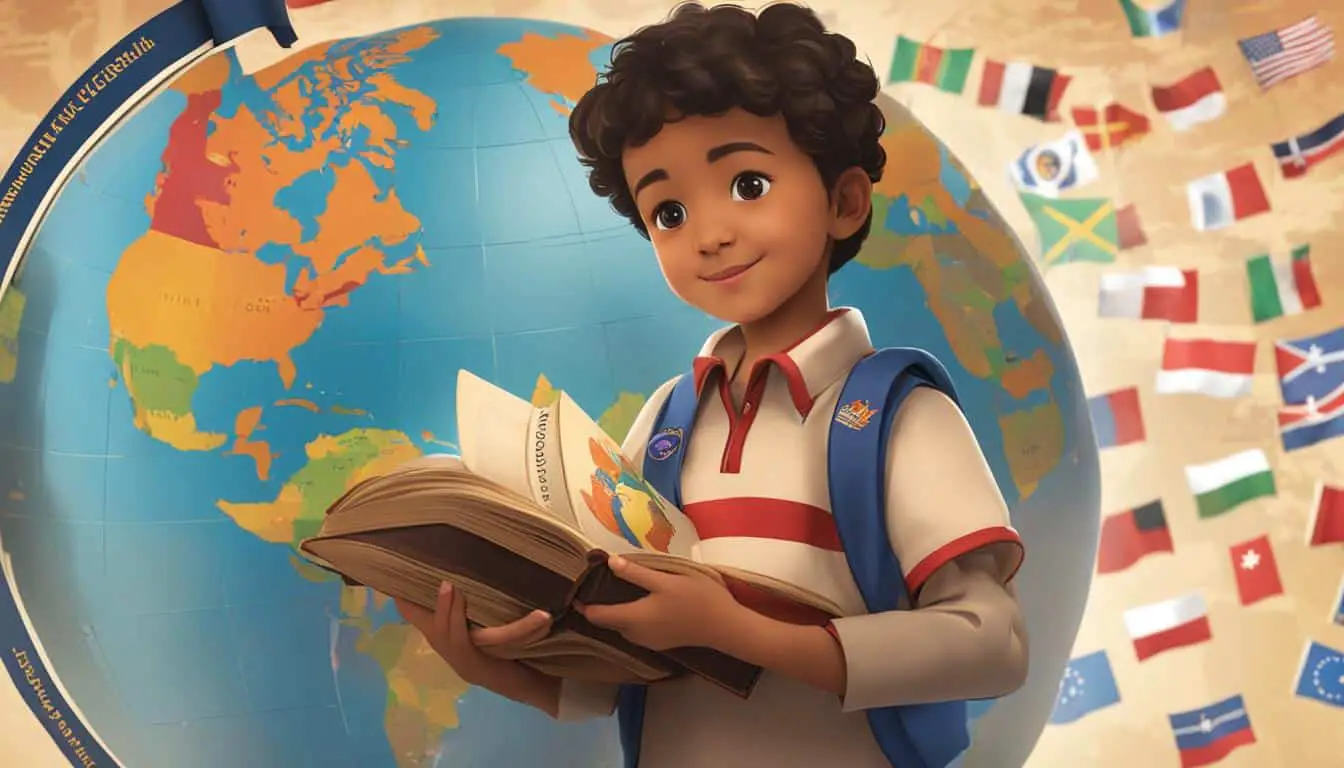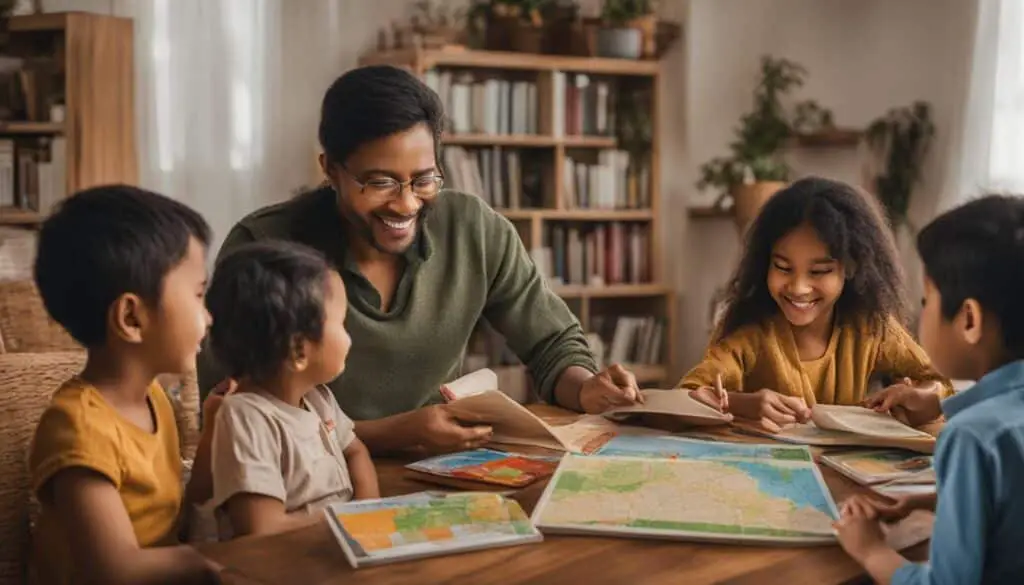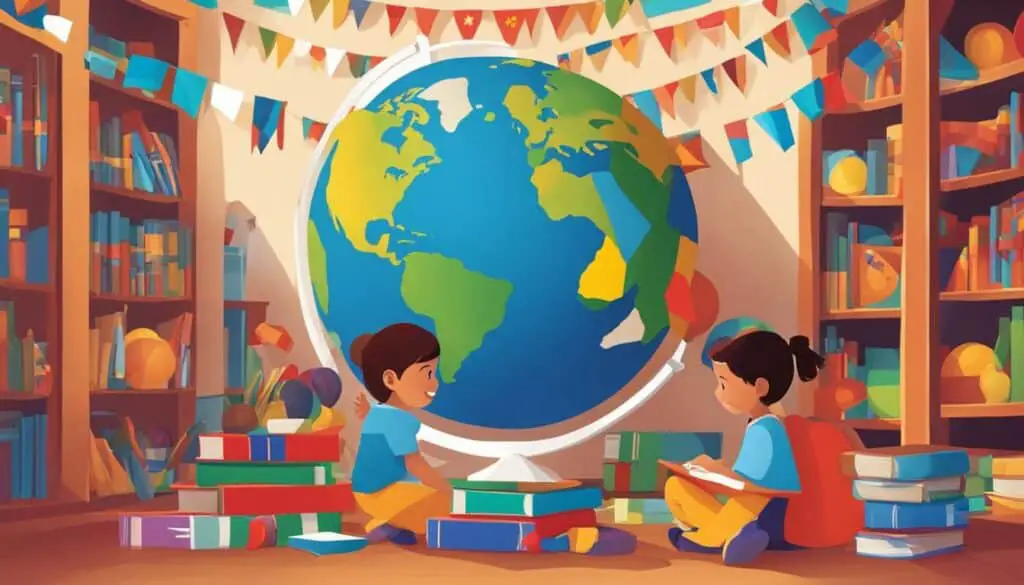
Raising Bilingual Children: Tips and Techniques
Raising bilingual children is a goal for many parents who recognize the cognitive, academic, and social benefits of learning multiple languages. In this article, I will explore five effective methods for raising bilingual children, based on research and expert advice. These methods include the “One Parent, One Language” approach, the “Minority Language at Home” technique, moving to another country, language immersion programs, and language classes at home and abroad. Each method offers its own unique benefits and challenges, but all aim to nurture and support dual language development in children.
Key Takeaways:
- Raising bilingual children has cognitive, academic, and social benefits.
- Effective methods for raising bilingual children include the “One Parent, One Language” approach, the “Minority Language at Home” technique, moving to another country, language immersion programs, and language classes.
- Consistent exposure to both languages is important in raising bilingual children.
- Creating opportunities for practice and interaction in the minority language is crucial.
- Maintaining a positive and supportive attitude towards language learning is key.
One Parent, One Language
The “One Parent, One Language” approach, also known as OPOL, is a popular method for raising bilingual children in families where each parent speaks a different language. In this approach, each parent consistently speaks only their native language to the child. For example, if a French mother and Cuban father are raising a bilingual child, the mother will only speak French to the child, and the father will only speak Spanish. The OPOL approach allows children to receive consistent exposure to both languages and encourages their language development in each language.
By following the OPOL approach, parents can create a linguistic environment that supports the child’s bilingual language development. When each parent consistently speaks their native language, the child becomes proficient in both languages, as they are exposed to the languages from a young age. This approach helps children develop a solid foundation in both languages and increases the likelihood of achieving fluency in both.
It is important for parents using the OPOL approach to provide ample resources and opportunities for the child to practice the minority language. This can include reading books, watching movies, and interacting with other speakers of the minority language. By creating a rich language environment and encouraging regular usage of both languages, parents can foster their child’s language development and help them become bilingual individuals.
By following the “One Parent, One Language” approach, parents can provide their children with the necessary language exposure and support to become bilingual. Consistency is key in this approach, as each parent consistently speaking their native language helps the child develop language skills in both languages over time. The OPOL method allows for effective language development and ensures that children are fully immersed in both languages at an early age.
Research has shown that the OPOL approach can be highly effective in raising bilingual children. It provides children with consistent exposure to both languages, which is crucial for their language development. This approach allows children to learn languages naturally, as they are consistently hearing and using both languages in different contexts.
To illustrate the effectiveness of the OPOL approach, here is a comparison table showcasing the benefits and considerations of this method for raising bilingual children:
| Benefits | Considerations | |
|---|---|---|
| Consistent Language Exposure | Children receive consistent exposure to both languages, facilitating language development in each language. | Parents need a strong commitment to speaking only their native language to the child. It requires discipline and consistency. |
| Clear Language Differentiation | Children quickly learn to distinguish between the languages spoken by each parent, enhancing their language awareness. | Parents may need to provide additional resources and opportunities for the child to practice the minority language, such as books, movies, and interactions with other speakers of the minority language. |
| Promotes Balanced Bilingualism | The OPOL approach aims to provide equal exposure to both languages, helping children achieve balanced bilingualism. | Parents need to manage language consistency, especially if one parent spends more time with the child or when extended family members primarily speak one language. |
Overall, the “One Parent, One Language” approach is a powerful method for raising bilingual children. With consistent language exposure and a supportive environment, children can develop strong language skills in both languages and reap the cognitive, academic, and social benefits of bilingualism.
Minority Language at Home
The “Minority Language at Home” or ML@H technique is another effective approach for raising bilingual children. This method is suitable for families where both parents are comfortable speaking one or more minority languages.
In the ML@H approach, the entire family uses the minority language at home, while using the majority or local language outside the home. This creates a clear language switch for the child and ensures consistent exposure to the minority language.
For example, an Italian mother raising her children in Sydney with her Australian husband may speak Italian at home and English outside.
This approach is particularly effective in fostering bilingual language development as it provides ample language exposure and opportunities for the child to practice the minority language within a supportive family environment.

In order to maintain the ML@H technique, it is essential for the parent using their non-native language to be diligent in maintaining their language skills. This can be achieved through regular practice, language resources, and interactions with other speakers of the minority language.
By implementing the ML@H technique and creating a home environment where the minority language is consistently used, parents can effectively support their child’s bilingual language development and provide a strong foundation for language learning.
| Advantages of the ML@H Technique | Challenges of the ML@H Technique |
|---|---|
|
|
Move to Another Country
Moving to another country can be an incredibly enriching experience for both parents and children alike. Not only does it offer the opportunity to explore a new culture and way of life, but it also presents a unique chance for bilingual language development. When a family moves abroad, they enter a linguistic immersion environment where the local language becomes a part of their everyday lives.
Parents can continue speaking their native language(s) at home, ensuring that their children maintain a strong connection to their roots. Simultaneously, the children have the unparalleled opportunity to learn and use the local language(s) at school and with friends, providing them with a natural context for language acquisition. This immersive experience fosters the development of fluency and proficiency in the language(s) of their adopted country, setting them up for success in an increasingly interconnected world.
Moreover, moving abroad also offers a study abroad experience for children at a young age. They get to live and breathe the language and culture of their new environment, expanding their global perspective and broadening their horizons. This experience can be particularly valuable for children who grow up as “third culture kids,” as they develop adaptability and comfort in international settings, paving the way for future academic and professional opportunities.
“Moving to another country provides an immersive language and cultural experience that accelerates bilingual language development and prepares children for a globalized world.”
Throughout this process, parents play a vital role in supporting their children’s language learning. They can provide additional language resources, such as books, movies, and interactions with other speakers of the minority language. By actively encouraging language practice and engagement, parents can create an environment that nurtures bilingual language development.
To illustrate the impact of moving abroad on bilingual language development, here is a table showcasing the benefits and considerations of this approach:
| Benefits of Moving Abroad for Bilingual Language Development | Considerations in Moving Abroad for Bilingual Language Development |
|---|---|
| Exposure to authentic language use | Adjustment to a new cultural environment |
| Opportunity for language immersion | Social integration challenges |
| Study abroad experience for children | Logistical considerations (e.g., housing, schools) |
| Development of global perspective | Navigating different educational systems |
Language Immersion Programs
Language immersion programs provide an excellent opportunity for raising bilingual children when moving abroad is not possible. These programs, often offered in foreign language schools, offer a comprehensive and immersive language-learning experience for children.
By participating in language immersion programs, children can reinforce their minority language skills while living in their home country or learn a second language from scratch. These programs create an environment where all classes are conducted in a foreign language, ensuring maximum language exposure and practice.
Language immersion programs not only focus on language development but also offer study abroad modules and intensive foreign language training. This opens doors for future tertiary study and career opportunities, giving children a competitive edge in a globalized world.
Furthermore, language immersion programs complement other language-learning experiences, such as language classes, summer camps, and interactions with fluent speakers of the target language. This holistic approach to language development maximizes language proficiency and cultural understanding.
Benefits of Language Immersion Programs:
- Intensive language exposure and practice
- Improved language fluency and proficiency
- Cultural immersion and understanding
- Study abroad opportunities
- Enhanced cognitive and academic skills
The combination of language immersion programs with other language-learning experiences creates a powerful language development journey that can truly transform a child’s bilingual language skills.
Language immersion programs are designed to provide a supportive and immersive environment where children can thrive and develop their language skills to their full potential. Whether it’s through study abroad opportunities or attending foreign language schools, these programs offer a unique and effective approach to raising bilingual children.

Conclusion
Raising bilingual children is a rewarding endeavor that requires dedication and intentional efforts from parents. By implementing effective strategies such as the “One Parent, One Language” approach, the “Minority Language at Home” technique, moving to another country, language immersion programs, and language classes, parents can create an environment that promotes bilingual language development in their children.
Consistent exposure to both languages plays a crucial role in language development. It is important for parents to provide ample opportunities for practice and interaction in the minority language, such as reading books, watching movies, and engaging with other speakers of the minority language. This consistent exposure allows children to gain fluency and proficiency in both languages.
Maintaining a positive and supportive attitude towards language learning is key. Celebrating milestones and achievements in both languages can boost children’s motivation and confidence. Parents can also seek support from bilingual communities and resources to further enhance their children’s language development journey.
With these tips and techniques, parents can empower their children to unlock the benefits of bilingualism, including enhanced cognitive abilities, multicultural awareness, and expanded opportunities in a globalized world. By nurturing bilingual language development, parents are equipping their children with valuable skills that will benefit them throughout their lives.
FAQ
What are some tips for raising bilingual children?
Some tips for raising bilingual children include using the “One Parent, One Language” approach, implementing the “Minority Language at Home” technique, considering moving to another country, enrolling in language immersion programs, and taking language classes.
What is the “One Parent, One Language” approach?
The “One Parent, One Language” approach, also known as OPOL, is a method where each parent consistently speaks only their native language to the child, providing consistent exposure to both languages and encouraging language development in each language.
How does the “Minority Language at Home” technique work?
The “Minority Language at Home” or ML@H technique involves using the minority language at home while using the majority or local language outside the home. This ensures consistent exposure to the minority language and creates a clear language switch for the child.
How can moving to another country contribute to bilingual language development?
Moving to another country allows parents to continue speaking their native language(s) at home while the children learn and use the local language(s) at school and with friends. This immersion in the local language(s) provides an opportunity for children to become fluent and proficient in the language(s) of their adopted country.
What are language immersion programs?
Language immersion programs are immersive experiences where all classes are conducted in a foreign language. These programs can be attended while living abroad or in the child’s home country, and they provide opportunities to reinforce minority language skills or learn a second language.